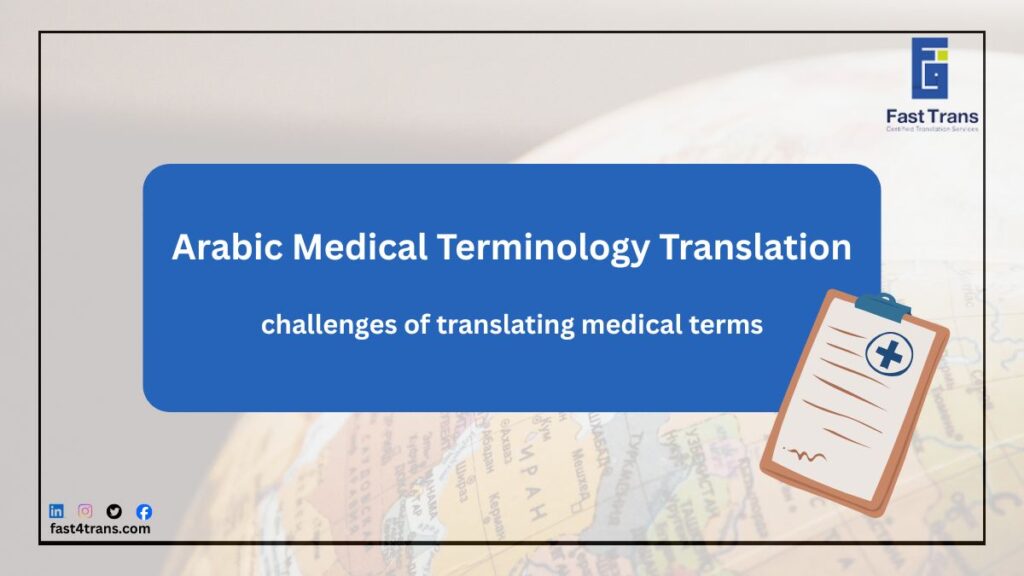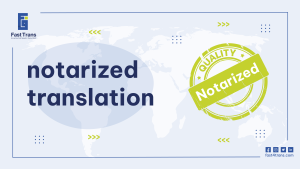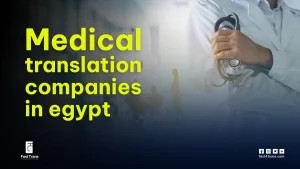Arabic medical terminology translation converts healthcare terms into Arabic. It’s complex due to multiple meanings, regional variations, and the need for deep understanding. Accurate translation is crucial for patient care, especially for prescriptions and technical terms.
Challenges include technical language, cultural nuances, abbreviation inconsistencies, and missing equivalents. Effective approaches involve using specialized dictionaries, translation memory, cultural sensitivity, and mnemonic devices. Relying solely on AI for medical translation carries risks, highlighting the need for human expertise.
What is Medical Terminology?
Medical terminology translation refers to the process of converting medical terminologies from the source to the target text. Medical terminology refers to a wide range of words/ vocabulary/ expressions/ concepts, that are used in the medical or healthcare field.
These terms can be anything such as anatomical structures diseases medical conditions operations disease treatments or names of medical devices.
The complexity of Arabic Medical Terminology Translation
Arabic medical terms are complex and challenging, which can make Arabic medical translation a daunting task.
Translating Arabic medical terms requires a solid understanding of their semantic structure. One term could have multiple meanings and interpretations, depending on the context. To avoid misinterpretation, Arabic medical translators need to always be up to date with the ever-changing Arabic medical terms around them.
They are also non-standardized, meaning that they change from one country or sector to the other. In very small medical sectors, specific Arabic medical jargon can be used, but because it is on such a small scale, the terminology rarely makes it to directories or dictionaries.
Prefixes and Suffixes
Usually, we can divide medical terms into three sections: the first one is the root, which is the basic structure of the word. Secondly, the prefix, which is the section that is put before the root, and thirdly is the suffix, which is the section that is added at the end of the word. Prefixes are added to indicate location, type, quantity, quality; basically, they give more sense to the root word. Unlike the prefix, the suffix has quite a different function because it usually indicates a procedure, a function, a disorder, a status of something, or a specialty.
Let’s apply this to these health conditions: Hypothyroidism and hyperthyroidism.
The prefix is a determining factor because (hypo) refers to an underactive thyroid gland, while (hyper) refers to the complete opposite, ‘hyperactivity’.
Read more: Top 10 Medical Translation Companies in Egypt
The Importance of Translating Medical Terms into Arabic
Accurate medical translation into Arabic is crucial for patient care in Arabic-speaking regions, ensuring clear communication between patients and healthcare providers. This specialized translation bridges language gaps in complex medical terminology, including prescriptions and technical jargon, preventing misunderstandings and potential harm.
1. Medical term interpretation into Arabic
Medical translation into Arabic can exist on the spot. When a foreign patient is admitted into a hospital in an Arabic-speaking country where the medical staff speaks Arabic, it’s crucial to have a translator who can accurately translate the patient’s needs, and also deliver to them what the doctors are saying in Arabic.
2. Solves the issues of equivalence in Arabic
Since medical texts are of a very sensitive and technical nature, medical terminology translation into Arabic steps in to fill the language gap, because a medical term in one language might not have a direct equivalent in Arabic. A medical translator will make sure that each term attains the same exact meaning when translated into Arabic. Consistency is crucial in translating technical and medical jargon such as abbreviations, acronyms, anatomical terms, etc. into Arabic.
3. Translating prescription labels into Arabic
Translating drug prescriptions into Arabic is essential in pharmaceutical translation because it provides valuable information for the patient in an Arabic-speaking country on how to use the drug. Without translation of terminologies into Arabic, the patient could misuse the drug, take the wrong dosage, or suffer from side effects they weren’t informed of.
Read more: Types of Translation
Arabic Medical Terminology Translation Challenges
Translating Arabic medical terminology faces challenges due to its highly technical nature, cultural nuances, and vast number of terms lacking direct equivalents. Consistency in abbreviations and regional variations further complicate accurate and context-specific translation across diverse medical specialties.
- Highly technical language and jargon.
- Difficulty in capturing the contextual and cultural nuances specific to the Arabic language and culture.
- Difficulty in maintaining consistency with abbreviations and acronyms in Arabic, considering variations in usage and interpretation.
- Lack of direct medical terminology equivalents in Arabic for some specialized terms.
- An incredibly high volume of terms, potentially numbering in the millions (as exemplified by resources like the UMLS Metathesaurus), posing a significant challenge for comprehensive Arabic translation.
- Medical terms encompass a wide scope of specialties (e.g., dentistry and psychiatry) with distinct terminology, further complicated by the interdisciplinary nature of medicine, extending beyond purely medical topics, and requiring accurate Arabic translation across these diverse fields.
- The existence of synonyms used in different contexts and registers (e.g., “Major depressive disorder” vs. “Clinical depression”) necessitates careful consideration of the appropriate Arabic equivalent for each context, distinguishing between professional and layman’s terms.
- Dependence on abbreviations (e.g., CA referring to Cancer, cardiac arrest, or calcium) presents translation challenges as the correct Arabic translation depends heavily on the specific medical context.
- Medical terms are non-standardized across different Arabic-speaking countries and even within different medical sectors of the same country, meaning that a term familiar in one context may be unfamiliar or have a different meaning in another, requiring careful adaptation and localization of Arabic medical terminology.
How to Approach Arabic Medical Terminology Translation?
When it comes to Arabic medical terms, translators and linguists are equipped with certain translation habits and tools that help them achieve accuracy and maintain consistency, that doesn’t involve binge-watching Grey’s Anatomy:
Firstly, they often consult specialized Arabic medical dictionaries and glossaries that keep Arabic medical terminology up to date.
Secondly, for consistency, they use tools like translation memories to make sure one Arabic term repeated in the same context is translated into the same word repeatedly because the opposite can result in confusion for medical staff members or a patient dealing with medical content.
Thirdly, they make sure to keep localization in mind. Part of an Arabic medical terminology translator’s job is to be aware of the cultural nuances of a given medical document. If not, so many things can lose their original meaning/effect in translation which can result in several things like confusing the reader, misguiding them, or offending them.
Fourthly, we previously mentioned that ‘medical terminologies’ are vast; therefore, translators of those terms attribute each term with a certain memorable image/video that can be their reference whenever they try to memorize that word.
Lastly, they use credible resources to keep their knowledge of Arabic medical terminology fresh, like WHO publications, MSD Manuals, Stedman’s Medical Dictionary, PubMed, and IMIA.
Technologies and techniques for Arabic Medical Terminology Translation
Arabic medical terminology translation is a highly specialized field that presents significant linguistic, technical, and cultural challenges. To address these, a combination of traditional techniques and modern technologies is employed.
Here are the key technologies and techniques:
1. Specialized Terminology Management Techniques
To handle complex medical terms, translators rely on established strategies that balance linguistic accuracy with practical communication needs.
a. Descriptive Translation & Coining:
Since direct, universally accepted Arabic equivalents for many modern medical terms (especially in areas like pharmacology or advanced diagnostics) often don’t exist, translators frequently use:
- Descriptive Translation: Explaining the concept in clear Arabic rather than a literal word-for-word translation (e.g., translating “Myocardial Infarction” with a descriptive phrase like ‘بَلْقٌ لِحْشَاَة الْقَلْب’ or the more standardized احتشاء العضلة القلبية).
- Arabization (or Coinage): Creating a new Arabic word based on the root structure or adopting a standardized, often semi-transliterated term that gains common usage.
b, Transliteration/Borrowing:
For brand names, specific diagnostic tools, or terms where the Arabic equivalent is obscure, the English term is often transliterated phonetically into Arabic (سي تي سكان for CT Scan, rather than a full descriptive translation).
c. Standardization & Consistency:
Using established medical glossaries and terminology databases to ensure that the same term is translated uniformly across all documents, which is crucial for patient safety and legal compliance.
2. Translation Technologies
Several technological tools are critical in modern medical translation workflows, addressing issues of consistency, speed, and data processing.
a. Translation Memory (TM) & Glossaries:
These tools are essential for maintaining consistency. Once a term is correctly translated and approved, it is saved in the TM and glossary, ensuring that every subsequent document uses the exact same high-quality translation for that term.
b. Machine Translation (MT) with Expert Review:
- AI-Powered Engines: Modern AI tools (like those used by specialized platforms) are increasingly fine-tuned on vast medical datasets to provide faster first drafts.
- Human Oversight (Post-Editing): Due to the life-or-death nature of medical texts, AI translation requires mandatory, expert human review by translators with subject-matter expertise. The AI handles speed; the human expert ensures nuance, accuracy, and cultural/contextual correctness.
c. Optical Character Recognition (OCR):
Technology to extract text from scanned medical records, images, or legacy documents, converting them into editable text that can then be processed by translation tools.
d. AI Assistants and LLMs:
Newer generative AI models are being trained specifically on Arabic medical dialogues and clinical notes to assist with tasks like medical transcription or generating synthetic data for training other models, thereby addressing the scarcity of high-quality Arabic medical datasets.
The overall strategy is a hybrid approach, balancing the speed and consistency offered by technology (AI, TM) with the essential accuracy, context understanding, and domain knowledge provided by specialized human medical translators.
Risks of Using AI in Translating Medical Terms
Medical translation using artificial intelligence carries risks due to potential inaccuracies and misinterpretations of context. AI tools may require extensive human review to ensure correct translations and cultural sensitivity, especially given the nuances of global healthcare practices.
1. Accuracy of Machine Translation
We’ve agreed that translating medical terms requires accuracy. However, machine translation-at least until very recently advanced ones-isn’t famous for accuracy. Machine translation or AI needs to be highly advanced and specialized in order to handle medical texts single-handedly. If not, then it can aid human translators in so far as quickening the translation process. However, it will often require human-machine translation post-editors to review the machine translation and edit any inaccuracies.
2. Interpretation of Contexts
Aside from the issue of accuracy, machine translation has a bad reputation for misinterpreting contexts, which is a task that can be safely put in the hands of human translators to take care of. Context involves within it the cultural nuances of a given medical text/term. It’s very important to keep cultural sensitivity in mind because medical jargon is not the same everywhere in the world, nor do healthcare systems work similarly in each country.
A recent example of these cultural sensitivities is how the medical field dealt with the topic of ethnic disparities during the 2020 COVID-19 pandemic, back then there were assumptions about how people of color were immune to the virus. You can imagine how sensitive it is to translate or even to write proper terms in such a context to refer to a disprivileged ethnic group in a medical context.
Key Pillars of Medical Translation QA
The focus in medical QA is on eliminating errors that could lead to misdiagnosis, incorrect treatment, or regulatory delays.
a. Accuracy and Precision:
Ensuring the meaning, including complex medical terminology, dosage instructions, and procedural descriptions, is conveyed with absolute fidelity to the source text.
b. Consistency:
Maintaining uniform terminology across all documents, especially in large clinical trials or ongoing patient care documents, to prevent confusion.
c. Regulatory Compliance:
Ensuring the translation adheres to specific national and international standards (like ISO 17100 or regulations from bodies like the FDA).
Core QA Steps and Best Practices or Successful Medical Terminology Translation
A robust QA process in medical translation typically involves multiple stages and highly qualified personnel:
1. Qualified Personnel Selection
- Expert Translators: Use native speakers of the target language who possess subject-matter expertise in the specific medical field (e.g., oncology, cardiology). A general translator is often insufficient due to the high-stakes nature of the terminology.
- Experienced Reviewers: The revision step should be performed by a second, equally qualified linguist, often referred to as bilingual editing.
2. Terminology Management
- Glossaries and Termbases: Create and strictly enforce client-specific medical glossaries or termbases to ensure consistency for every term, drug name, or procedure across the entire project.
- Translation Memory (TM): Utilize TM systems within Computer-Assisted Translation (CAT) tools to ensure recurring segments are translated identically, enhancing consistency and efficiency.
3. Multi-Stage Review Process
A common structured approach includes:
- Translation & Self-Editing (Tier 1): The initial translator reviews their own work for typos, grammar, and initial adherence to instructions.
- Editing/Revision (Tier 2): A second linguist performs a word-for-word check against the source text, focusing on accuracy and meaning.
- Proofreading/Final Review (Tier 3): A final check for fluency, readability, correct formatting, and proper insertion of graphics or numerical checks, ensuring the text reads naturally in the target language.
- Subject Matter Expert (SME) Review: For highly technical or critical documents, a healthcare professional (doctor, pharmacist) may review the translation to validate medical context and terminology.
4. Specialized Checks
- Numerical Verification: Crucial checks must be performed on numbers, dosages, frequencies, and units to prevent medication errors.
- Back-Translation (BT): Sometimes used as an extra validation layer, where the target text is translated back into the source language and compared against the original to catch significant meaning shifts. However, reliance on BT alone is often discouraged as it favors literalness over natural expression.
- Localization and Cultural Review: Assessing if the content is appropriate for the target country’s specific medical practices and cultural norms.
The Role of Arabic Medical Translators
The role of an Arabic medical translator is pivotal in bridging the linguistic and cultural divide within healthcare, pharmaceutical research, and medical device industries. Given the high-stakes nature of medical information, their function goes far beyond simple language conversion.
Arabic medical translators primarily deal with converting written medical content between Arabic and source languages (often English). Their key responsibilities include:
- Translating Medical Documentation: Handling a wide range of texts, including:
- Patient records, medical histories, and lab results.
- Informed consent forms (ICFs) and patient information leaflets.
- Clinical trial protocols and research articles.
- Medical device instructions and pharmaceutical product labels.
- Ensuring Patient Safety: Accurately translating information like drug dosages, treatment plans, and diagnostic summaries is paramount to prevent medical errors and ensure patient well-being.
- Maintaining Confidentiality: Adhering strictly to privacy regulations (like HIPAA in relevant contexts) when handling sensitive patient health information (PHI).
Essential Qualifications in the Arabic Medical Translators
To meet these challenges, Arabic medical translators require:
a. Bilingual Fluency:
Native or near-native proficiency in Modern Standard Arabic and high proficiency in the source language.
b. Medical Expertise:
A deep, specialized knowledge of the relevant medical and scientific terminology and concepts. This often means having a background in life sciences or specialized training.
c. Cultural Competency:
Understanding the cultural context of the Arab world is vital, as cultural nuances can influence how health information is perceived and communicated, particularly in patient-provider interactions.
d. Professional Certification:
Certification from recognized bodies (like passing the Arabic track exam for certifications from CCHI or ATA) validates their proficiency and adherence to ethical standards.
In essence, the Arabic medical translator acts as a highly skilled knowledge mediator who ensures that complex, critical medical data is communicated with precision, consistency, and cultural respect, directly supporting equitable access to quality healthcare for Arabic speakers.
Rely on Fast trans medical translation experts
So far we’ve established that medical terminology translation is a task that requires expertise and solid background knowledge. That being said, Fast Trans is there to fulfill any medical translation task that you might be struggling with. As a leading translation company in the MENA that has landed giant clients over the years, we pride ourselves on the ones who found the sweet spot between translation quality, client satisfaction, and a rock-bottom price.
We work with a network of highly skilled specialized translators, including medical ones who can understand your translation needs, provide free translation samples, ensure confidentiality of information, and ensure short turnaround times.
Your journey with us starts here.
What Our Customers Say
Since the translation project is theirs, we encourage the clients to discuss every stage of the process.
You can check our clients’ comments for yourself at Google Reviews.
FAQs
What are some problems that might occur in the translation of medical terminology?
Translating medical terminology presents numerous challenges due to the specialized nature of the language and the necessity for precise communication. One significant issue is synonyms where medical terms can be written differently but have the same meaning. Another problem encountered in medical terminology translation is the use of abbreviations and acronyms, some of which require context because the same abbreviation is used for multiple acronyms. Additionally, translators need to be aware of cultural and regional differences. For example, the classification of insulin types might not be universally standardized or might have different approved translations in different countries.
What is a big issue that comes with the translation of medical terms?
If one thing, accuracy is the main hurdle when it comes to medical terms translation, because it demands translators to have years of experience, knowledge of different medical specializations, localization of cultural nuances…etc.
What are the challenges of medical interpretation?
Medical interpretation can be challenging in many ways. First and foremost, is the cultural differences of patients which can influence everything from how they describe their symptoms, to how they receive medical advice. It’s the interpreter’s job to bridge the gap. In addition to that, they can be challenged by emotional and psychological stress because of the nature of the high-stress environment like a hospital ER. Other challenges included: meeting accuracy with speed and attentiveness, and interpreting non-verbal communication of patients or healthcare professionals.
Conclusion
Arabic medical terminology translation is the specialized process of converting healthcare-related vocabulary from a source language into Arabic. This includes a broad range of terms related to anatomy, diseases, treatments, medical devices, and procedures. The complexity of this task stems from several factors: Arabic medical terms often have multiple interpretations depending on context, they are subject to regional variations and lack standardization, and they require deep understanding of semantic structures, prefixes, and suffixes. Accurate translation is critical for patient care, ensuring clear communication between healthcare providers and Arabic-speaking patients, especially regarding prescriptions and technical jargon.
Translating medical terminology into Arabic presents several challenges. These include the highly technical nature of the language, the difficulty in capturing cultural nuances, inconsistencies in abbreviations, and the lack of direct equivalents for some specialized terms. The sheer volume of medical terms, coupled with variations across specialties and regions, further complicates the process. Effective approaches to Arabic medical translation involve consulting specialized dictionaries and glossaries, utilizing translation memory tools for consistency, considering localization and cultural sensitivity, and employing mnemonic devices for memorization. Relying solely on AI for medical translation carries risks due to potential inaccuracies and misinterpretations of context, highlighting the need for human expertise in this sensitive field.











